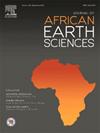冈瓦南北缘新元古代大陆弧岩浆作用:土耳其南部东部Taurides长英质侵入岩的地球化学和U-Pb年代学
IF 2.2
4区 地球科学
Q2 GEOSCIENCES, MULTIDISCIPLINARY
引用次数: 0
摘要
土耳其南部的东牛头期是冈瓦南边缘的一个关键时期,但其新元古代岩浆历史在很大程度上仍然是不受限制的。本研究首次获得了侵入奥鲁帕拉鲁组前寒武纪变质沉积岩的长英质次火山侵入岩的地球化学和年代学数据集,包括花岗闪长斑岩、闪长斑岩、微花岗闪长岩和阿普立特岩脉。野外观测显示,多期岩浆侵位具有边缘冷却、变质沉积包体停止、侵位后变形等特征,表明在构造活跃的弧环境下发生结晶。全岩地球化学特征表明,成矿、高钾钙碱性特征,LILEs (Rb、Th、U、Pb)富集,HFSEs (Nb、Ta、Ti)亏缺,与俯冲变质地幔源形成的i型花岗岩相一致。低Sr/Y比值和无埃达质特征表明岩浆成因在地壳深处,没有石榴石残留,这是典型的大陆弧体系。U-Pb锆石结晶年龄为642.2±7.5 Ma,确定侵位于卡多东早期造山运动时期,与原特提斯洋俯冲的开始时间一致。在地球化学上,Horzum长英质侵入物与Bitlis地块、土耳其西北部和伊朗的其他埃迪卡拉-寒武纪花岗岩类具有相似之处,支持冈瓦纳北缘存在一个区域性广泛的安第斯型大陆弧体系。这些结果有助于填补东地中海地区新元古代岩浆记录的一个关键时空空白,并为冈瓦南边缘地壳演化提供新的约束条件。尽管它们的暴露程度和体积有限,但这些侵入岩对土耳其南部卡多米尼亚岩浆活动提供了重要的新限制,并确立了冈瓦南北部边缘作为东地中海地区新元古代地壳生长的关键场所。本文章由计算机程序翻译,如有差异,请以英文原文为准。
Neoproterozoic continental arc magmatism along the northern Gondwanan Margin: Geochemistry and U–Pb geochronology of felsic intrusions from the eastern Taurides, Southern Turkey
The Eastern Taurides of southern Turkey represent a critical segment of the peri-Gondwanan margin, yet their Neoproterozoic magmatic history remains largely unconstrained. This study presents the first integrated geochemical and geochronological dataset from felsic subvolcanic intrusions—including granodiorite porphyry, tonalite porphyry, microgranodiorite, and aplite dikes—that intrude the Precambrian metasedimentary rocks of the Oruçlu Formation. Field observations reveal polyphase magmatic emplacement with features such as chilled margins, stoped metasedimentary enclaves, and post-emplacement deformation, suggesting crystallization in a tectonically active arc setting. Whole-rock geochemistry indicates metaluminous, high-K calc-alkaline signatures with enrichment in LILEs (Rb, Th, U, Pb) and depletion in HFSEs (Nb, Ta, Ti), consistent with I-type granitoids derived from a subduction-modified mantle source. Low Sr/Y ratios and the absence of adakitic signatures point to magma genesis at moderate crustal depths without garnet residue, typical of continental arc systems. A U–Pb zircon crystallization age of 642.2 ± 7.5 Ma confirms emplacement during the early Cadomian orogeny, coinciding with the onset of Proto-Tethys Ocean subduction. The Horzum felsic intrusions show close geochemical similarities to other Ediacaran–Cambrian granitoids in the Bitlis Massif, NW Turkey, and Iran, supporting the existence of a regionally extensive, Andean-type continental arc system along the northern margin of Gondwana. These results contribute to bridging a key spatial and temporal gap in the Neoproterozoic magmatic record of the Eastern Mediterranean region and provide new constraints on crustal evolution along the peri-Gondwanan margin. Despite their limited exposure and volume, these intrusions provide critical new constraints on Cadomian magmatism in southern Turkey, and establish the northern Gondwanan margin as a key locus of Neoproterozoic crustal growth in the Eastern Mediterranean region.
求助全文
通过发布文献求助,成功后即可免费获取论文全文。
去求助
来源期刊

Journal of African Earth Sciences
地学-地球科学综合
CiteScore
4.70
自引率
4.30%
发文量
240
审稿时长
12 months
期刊介绍:
The Journal of African Earth Sciences sees itself as the prime geological journal for all aspects of the Earth Sciences about the African plate. Papers dealing with peripheral areas are welcome if they demonstrate a tight link with Africa.
The Journal publishes high quality, peer-reviewed scientific papers. It is devoted primarily to research papers but short communications relating to new developments of broad interest, reviews and book reviews will also be considered. Papers must have international appeal and should present work of more regional than local significance and dealing with well identified and justified scientific questions. Specialised technical papers, analytical or exploration reports must be avoided. Papers on applied geology should preferably be linked to such core disciplines and must be addressed to a more general geoscientific audience.
 求助内容:
求助内容: 应助结果提醒方式:
应助结果提醒方式:


